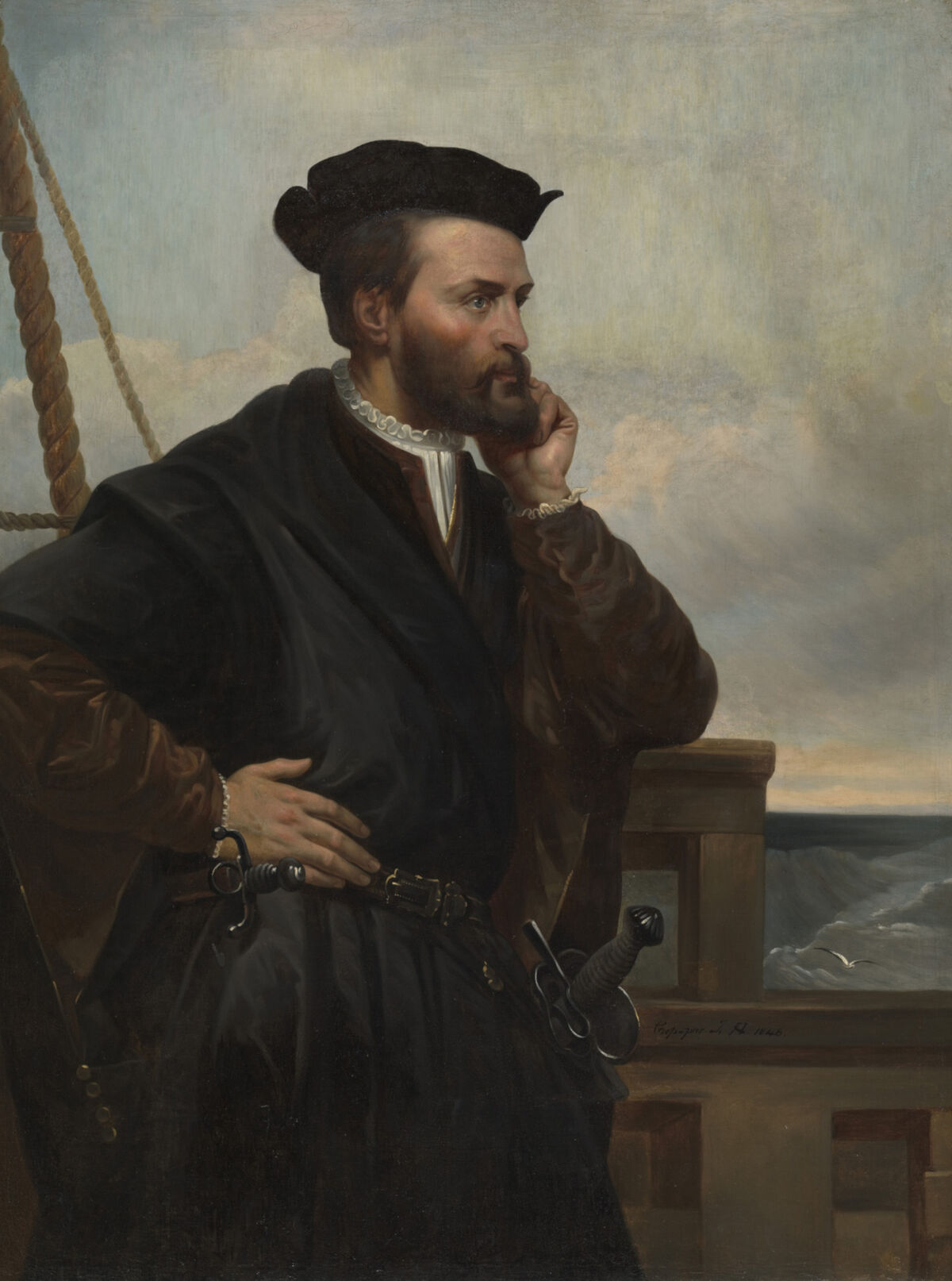
Source: Jacques Cartier [Toile], Hamel, T., 1848, Musée national des beaux-arts du Québec collection, (URL). All rights reserved*
Jacques Cartier (1491-1557) was a French navigator, explorer and cartographer. He was the first European to explore the St. Lawrence River and to use the name Canada in his writings. At the time, Canada referred to the area around present-day Quebec City. He is best known for helping France gain a better understanding of the territory, among other things by creating the first accurate maps of the Gulf and part of the St. Lawrence River, thanks to his 3 voyages.
Around 1532, François 1er, King of France, appointed Jacques Cartier to lead an expedition of exploration. At the king's expense, the navigator was to make voyages to the New World, seeking a passage to Asia and discovering new riches.
Cartier's first 2 voyages (1534 and 1535-1536) were promising. He explored the Gulf, then the St. Lawrence River, and came into contact with several native communities. In the process, he developed a better understanding of the territory and its inhabitants.
The aim of the 3rd voyage (1541-1542) was to begin colonizing Canada and spreading the Catholic faith. This time, Jean-François de La Rocque de Roberval was appointed fleet commander. However, he had to remain in France while Jacques Cartier set sail for the new continent in 1541. Roberval's fleet was to join Cartier's the following year.
During this voyage, Cartier's crew and the colonists accompanying them faced many challenges. They had to spend the winter for the 2nd time, and relations with the native communities were sometimes very difficult. The summer after their arrival, they set sail for France, leaving behind the settlements they had built to found a new colony. Along the way, they came across Roberval's fleet, bound for Canada. Refusing to join the fleet and return to Canada, Cartier returned to France. He had the stones he had brought with him analyzed. What he thought were gold and diamonds were in fact iron pyrite and quartz, 2 minerals of little value.
Roberval's fleet, for their part, attempt to establish a colony on the same site as Cartier. After a difficult winter, the survivors returned to France, thus completing the first series of French colonization attempts in Canada.
After these unsuccessful attempts, France lost interest for a time in any exploration or colonization of what would become New France.
To find out more about Jacques Cartier and France's colonization plans, visit
The first colonization attempt by the French in America.
-
1491: Jacques Cartier is born in Saint-Malo (Brittany).
-
1534: At the behest of King François 1er, Jacques Cartier leaves France to explore the Newfoundland region and seek a passage to Asia. During this first voyage, he explores the Gulf of St. Lawrence and establishes relations with native communities on Chaleur Bay. He also planted a cross in Gaspé, claiming the territory in the name of the King of France. He returns to France after rounding Anticosti Island.
-
1535-1536: Jacques Cartier makes his second voyage to Canada. This expedition included 3 ships: La Petite Hermine, L'Émérillon and La Grande Hermine. He reaches Hochelaga, a fortified native village on what is now the island of Montreal. During their first winter in Canada, the men of his crew fell victim to scurvy, but recovered thanks to a native remedy based on conifer bark. Leaving for France the following summer, Jacques Cartier forcibly brought Donnacona, chief of the Iroquoian village of Stadaconé, and 9 other natives with him. All of them died in France. Before his death, Donnacona hints to François 1er, King of France, that the Kingdom of the Saguenay abounds in gold, precious stones and spices.
-
1541-1542: Jacques Cartier makes his third voyage to New France. When he arrives, he has the Charlesbourg-Royal fort built in preparation for colonization. Relations with the native peoples deteriorate. The summer after their arrival, Jacques Cartier returns to France, bringing with him what he believes to be gold and diamonds. In Newfoundland, he came across the expedition of Jean-François de la Rocque de Roberval, commander-in-chief of the third French expedition, heading for Canada. Cartier continues on to France, while Roberval heads for Charlesbourg-Royal in Canada.
-
1543: Due to numerous conflicts with the natives and a difficult first winter, Roberval returns to France with all survivors of the fledgling colony. This puts an end to the first attempts at French colonization in Canada.
-
1545: The accounts of Jacques Cartier's second voyage are published.
-
1557: Jacques Cartier dies on September 1, in Saint-Malo (Brittany, France).
Hamel, T. (1848). Jacques Cartier. Collection du Musée national des beaux-arts du Québec. https://collections.mnbaq.org/fr/oeuvre/600039694 *Extract used by Alloprof in accordance with the Copyright Act for fair use for educational purposes.